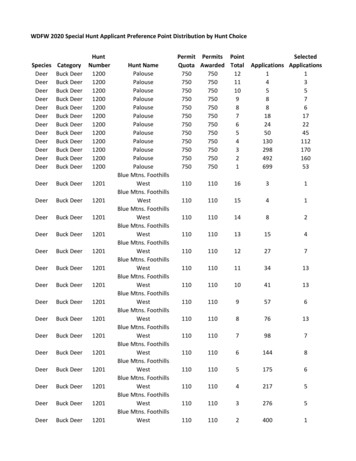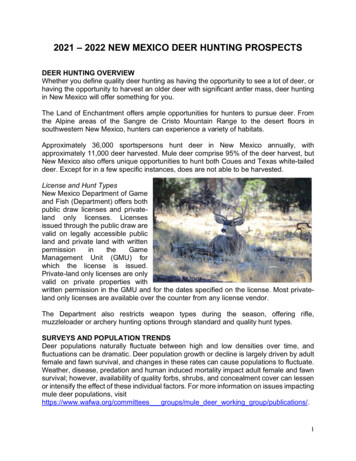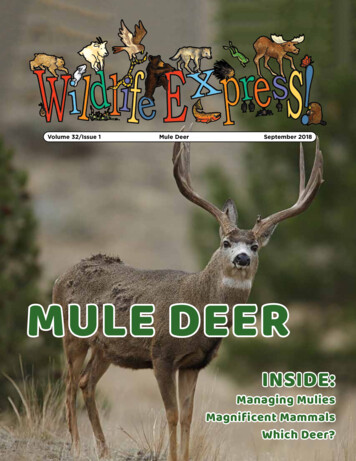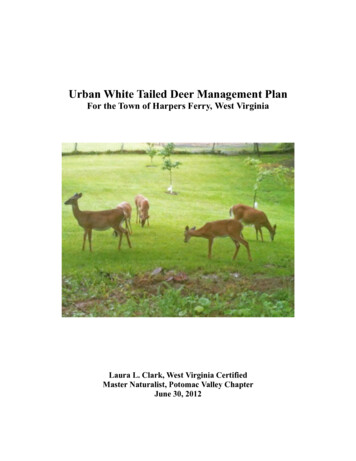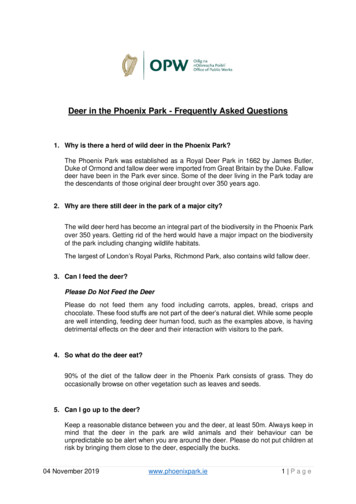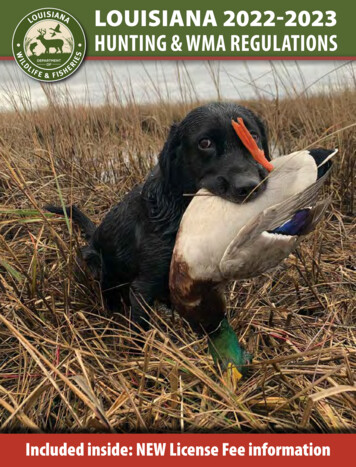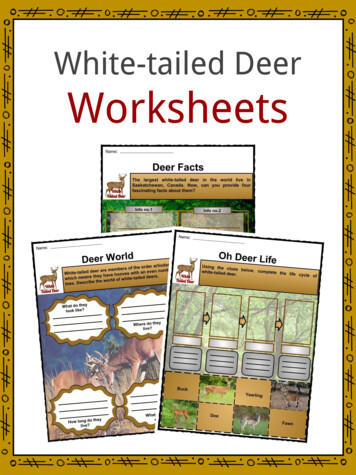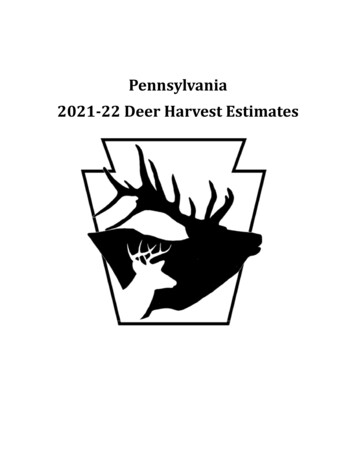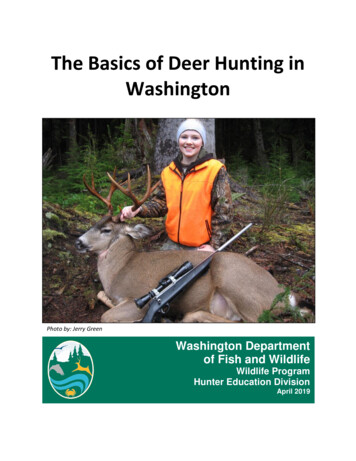
Transcription
The Basics of Deer Hunting inWashingtonPhoto by: Jerry GreenWashington Departmentof Fish and WildlifeWildlife ProgramHunter Education DivisionApril 2019
(This page intentionally left blank.)2
Table of ContentsIntroduction . 5License and Tag Choices . 6Deer Species . 7Black-tailed deer. 7White-tailed deer . 8Mule deer . 10Columbian white-tailed deer. 12Deer identification tool . 12General Deer Information . 12Food and Feeding Habits . 13Tracks. 15Droppings . 15Bedding areas . 16Rubs . 16Scrapes . 16General Deer Hunting Techniques . 16Hunting Equipment . 17Archery equipment . 17Muzzleloader equipment . 19Modern Firearm Equipment. 21Clothing and Concealment . 22Knives . 25Optics . 26Calls to use. 26Where to Go. 27Hunting Ethics . 28Shot placement . 28Broadside. 28Quartering away . 29Quartering to . 29Head on . 29Rear end . 29Tracking . 29Tagging . 30Field Dressing . 30Skinning . 31Processing . 32Hunter Reporting . 32NOTES. 34Ten Basic Safety Rules. 353
The information contained in this manual was collected from the WashingtonDepartment of Fish and Wildlife website (wdfw.wa.gov) and its employeesunless otherwise cited. (2016)4
IntroductionWelcome to deer hunting! This course should provide you with basic knowledge about deerhunting in Washington State and give you a general guide to be successful. It should also serveto help you in your hunting pursuits.In our Basic Hunter Education course, we teach students how to hunt safely. This course isdesigned to give you an overview of the biology and habits of Washington’s deer species andhow to hunt them effectively. This guide will also help teach you about game handling, huntingequipment regulations and choices, correct shot placement, hunter reporting, and much more.These topics will help you become more knowledgeable as a hunter and make the animals youharvest become great table fare.One thing to remember when pursuing any animal is that it is called hunting for a reason. Youmay not be successful in harvesting an animal every day, or every season. That’s part of theenduring challenge and fun of hunting. Each season brings a new opportunity to hone yourskills. To properly set your expectations, check the annual harvest statistics, which are postedon the WDFW website at http://wdfw.wa.gov/hunting/harvest.For most of us, hunting is about much more than a successful harvest. It’s about spending timeafield bonding with family and friends, watching the sunrise over the mountains on a crisp fallmorning, and having exciting stories to tell when you get home.Photos by WDFW and Shari Brewer5
License and Tag ChoicesWDFW offers many different licenses that allow you to deer in Washington. Unlike many otherstates, Washington offers species-specific big game licenses that include a transport tag in thecost of the license. This system allows you the flexibility to buy each species option individually,or receive discounts if you buy a bundled multi-species package (see below for an example ofbig game license packages). You can also receive a discount if you purchase your small gamelicense and a big game license together. Remember that you will not receive the discountunless the license items are purchased at the same time.The licenses listed below are available for purchase by any hunter over-the-counter and giveyou the ability to hunt during the general hunting season.The general season big game license choices are as follows: Deer, Elk, Bear, and Cougar License Deer, Elk, Bear, and Cougar License W/discounted Small game Deer and Elk License Deer and Elk License W/discounted Small game license Deer License Deer License W/discounted Small game license Elk License Elk License W/discounted Small game license Bear License Bear License W/discounted Small game license Cougar License Cougar License W/discounted Small game licenseBig game licenses are issued based on species option, but transport tags are more specific. Fordeer, you must declare a weapon type (archery, muzzleloader, or modern firearm) to receiveyour transport tag. If you haven’t decided on a weapon type when you buy your license(s), youcan choose to have your tag printed later, but make sure you get your tag before you hunt.Deer can be hunted with archery, muzzleloader, or modern firearm hunting equipment. Thehunting seasons for deer are broken down by equipment choice. Making hunters choose theirseason and equipment helps prevent overcrowding during the hunting season. WDFW sets theseason length based on harvest rates and seasonal animal surplus projections.A hunter who chooses archery can only use archery equipment during the archery season.Muzzleloader season tag holders can use archery or muzzleloader equipment duringmuzzleloader season. Those hunters who choose modern firearm can use archery,muzzleloader, or modern firearm equipment during the modern firearm season. Rememberthat you may only hunt in the season that matches your tag.6
Deer SpeciesWashington State is home to four subspecies of deer. Of those four, hunters are able to huntthree, black-tailed, white-tailed, and mule deer. The fourth is the Columbian white-tailed deer,which is currently on the endangered species list.Black-tailed deerSuccessful hunting for black-tailed deer isprimarily a function of the effort, focus,and energy that hunters put into the hunt.Black-tailed deer thrive in heavilyvegetated habitats and are oftennocturnal in nature. This means thatsuccessful black-tail hunters must be inposition early in the morning and carefullyhunt near sources of food and in securecover.Black-tailed deer hunting is often bestnear the end of the general season, asconditions in the heavily vegetated westPhoto by Antony Sirgedasside improve for stalking and movingthrough the woods quietly. The best opportunity often occurs during the late buck hunt, whenfavorable stalking and weather conditions combine with the breeding season or rut. The mostsuccessful hunters study the area carefully and move very slowly, constantly searching for deer.Bucks travel more during the rut, when they cover large amounts of territory searching for doesin estrus. This makes bucks more vulnerable as they spend less time hiding and are sometimesfound in “open” habitats, like clear-cuts and meadows.Here is a map of where you may expect to see these deer:7
Species descriptiono Black-tailed deer occur from the crest of the Cascades west to the Washingtoncoast, preferring brushy, logged lands and coniferous forests.o The tail is broader and the backside of the tail is covered with dark brown hairthat grades to black near the tip.o Adult black-tailed deer bucks weigh 140 to 200 pounds and adult does weigh 90to 130 pounds.o The antlers have a main beam that forks in adult bucks.o Dark colored bellyo Grey to brown faceShelter and range needso Black-tailed deer normally reside within a one half to three square-mile area. Inmountainous locations, they migrate to lower elevations for the winter.o Deer numbers differ among habitat types and the highest deer densities areassociated with five to seven-year old clear cuts. These young tree standsprovide large amounts of both cover and food.o Those areas with cover are more likely to contain deer for the majority of theday.Hunting techniqueso The traditional approaches to hunting black-tails include stand hunting or stillhunting in high use areas (clear cuts, highly traveled trails, funnels, bedding areasetc.) until the deer show up. Sitting in a blind or tree stand can be a very effective way to hunt blacktailso Hunt the edges Watch edges of tree lines and fields. Deer like to hug these areas forquick escapes and movement into cover. Spot and stalk can work when hunting large clear cuts. This technique isgenerally not an efficient way to hunt black-tails in areas with very thickundergrowth and brush.White-tailed deerWhite-tailed deer are generally found in theeastern third of Washington. Look for whitetailsalong stream drainages and in other areas withriparian vegetation or thick cover. Whitetailsactively use edge habitats where denser coverabruptly transitions into more open meadows.Many white-tail hunters will wait patiently at astand along an obvious game trail or the forestedge, often employing the use of a blind or treestand. The majority of hunting success is near oradjacent to agricultural fields or recent forestPhoto by Larry Smith8
timber harvest areas where deer are present and much more visible than in adjacent habitats.However, deer typically use these more open areas at night, dawn, and dusk, especially if theyhave been disturbed by human presence. Therefore, it is advantageous for hunters to seek outareas some distance away from these openings, where there is more cover available, since thedeer are spending more time there. If a hunter is seeing large amounts of deer sign in an area,then odds are those deer are not far away. White-tailed deer densities are highest along thevalleys and foothill benches bordering valleys in the farm-forest mosaic. These areas are highlyproductive both in crops and deer production.Here is a map of the white-tailed deer’s distribution in Washington. Species descriptiono White-tailed deer coats are often reddish tan in summer and brownish gray inwinter. They get their name from their broad, 10 to 11 inch-long tail. Whenalarmed, white-tailed deer raise their tail, displaying the white underside.o Adult white-tailed bucks weigh 150 to 200 pounds and adult does weigh at 110to 140 pounds.o Antlers have one main beam with tines extending vertically in most cases.o White facial markingso Light colored bellyShelter and range needso White-tailed deer are found across a wide variety of landscapes in easternWashington, from low land riparian areas along water courses to high elevationsin the mountains.o The highest densities are associated with agricultural lands at lower elevations.Whitetails are present near populated areas.o White-tailed deer home ranges vary considerably in size in eastern Washington.Some annual home ranges are relatively small (three square miles) or quite largein seasonal migratory white-tail populations.9
Hunting techniqueso The traditional approaches to hunting whitetails include stand hunting or stillhunting in high use areas (e.g., clear cuts, highly traveled trails, funnels, andbedding areas) Sitting in a blind or tree stand is a very effective way to hunt white-tailso Rattle and grunt calls to simulate two bucks fighting over a doe is more commonwith mid-western and eastern white-tailed states, but can be effective here aswell, especially in the days leading up to the rut (deer breeding season) in midNovember.o Hunt the edges Watch edges of tree lines and fields. Deer like to hug these areas forquick escapes and movement into cover. Spot and stalk can be an efficient way to hunt white-tails where thehabitat is more open.Mule deerMule deer are present across most of easternWashington. Mule deer populations in easternWashington exhibit a variety of seasonal movementpatterns, with migratory herds moving up to 50straight line miles between summer and winterranges to resident animals with annual home rangessimilar in size to resident white-tail populations.Migratory mule deer are often at high elevations inremote locations as long as succulent vegetation isavailable. Although mule deer will use a variety ofhabitat types, they will often forage well into fairlyopen environments, particularly at dawn and dusk. Asa result, they can often be glassed and stalked fromconsiderable distance. A typical hillside of mule deerhabitat in the Cascades over the growing season andthrough the fall will change from bright green in thespring and summer to light green or yellow, toPhoto by Susan Jensenorange, to red, to brown, then to bare branches.While we see changes in color, mule deer areperceiving changes in forage quality. The summer forage that supports deer and gives them theopportunity to produce young and grow antlers does not retain its high quality all year. As itchanges, so do the habitats that deer occupy. Even large expanses of sagebrush can give deerthe security they need. In the broken coulee country, topography becomes security and riparianvegetation provides food resources. Deer in these areas often become experts at living in small,secure habitat pockets where they meet their needs and avoid hunters.10
Mule deer hunters can expect to find mule deer in the following areas: Species descriptiono During the summer, mule deer coats are often reddish-tan to light brown. Duringwinter, they are a salt-and-pepper gray.o They have large, dark-edged ears, from whence they derive their name.o The seven to eight inch ropelike tail of a mule deer is white, except for a blacktip.o Adult mule deer bucks weigh up to 250 pounds and adult does weigh 110 to 200pounds.o The antlers have a main beam that forkso Face is greyish in coloro Darker colored bellyShelter and range needso They occur in eastern Washington at all elevations.o Mule deer generally move long distances during spring and fall migrations toavoid mountain snow. Mule deer summering in the Cascades migrate as far as 50miles to reach adequate winter range.Hunting techniqueso The classical western method of hunting mule deer is called spot and stalk. Herethe hunter uses good optics, binoculars, and spotting scopes to scan from ridgetops and other vantage points to find the mule deer, pick out suitable bucks, andthen stalk them to within shooting distance. Ordinarily the stalk entails astrategic hike and cautious sneak action.o Some mule deer hunters employ stand or still hunting techniqueso Hunt the edges Watch edges of tree lines and fields. Deer like to hug these areas forquick escapes and movement into cover.11
Columbian white-tailed deerThe Columbian white-tailed deershares portions of its range with theblack-tailed deer in westernWashington. When hunting in thoseareas, be sure of your target. To theright is a map of the Columbianwhite-tailed deer range.The Columbian white-tailed deer is afederally and state listed endangeredspecies and cannot be hunted, so isnot discussed in depth in this booklet.To learn more about the Columbianwhite-tailed deer, see ileus-virginianusleucurus.Deer identification toolBelow is a graphic depicting each of Washington’s deer species. This should help hunters toquickly identify deer. The tails will help identify the species of deer when they are a doe or atwo point buck. Make sure to clearly identify if a deer is legal before harvesting.General Deer InformationDeer are creatures of habit, so knowledge of deer habits and movement patterns are valuableto hunters in finding deer during different times of the day and season. Deer are most activeduring the early morning and late afternoon-evening.12
Food and Feeding HabitsDeer tend to feed before dawn,and if undisturbed, continueuntil several hours after sunrise.After feeding, deer will beddown for most of the middlehours of the day. Although it iscommon for bedded deer to getup and feed for 30 to 60minutes around noon, then beddown again. Deer will return tofeeding late in the afternoon andcontinue until after sunset.Examples of bushes browsed by deerPhoto by WDFWDeer eat a wide variety of plants, ranging from newly sprouted grasses and forbs in the springto fir needles during the winter. In general, deer tend to be browsers, eating the growing tips oftrees and shrubs. In late winter and early spring, deer eat grass, clover, and other herbaceousplants. Deeralso eat fruit,nuts, acorns,fungi, lichens,and farm andgarden crops ifavailable.What foods adeer will preferdepends greatlyon the speciesof deer and thehabitat wherethey live (seethe table belowfor speciesspecific foodpreferences).A browse lineLook for areasPhoto by WDFWwhere the treesand other plants seem to have a line of missing limbs or leaves from the ground to about deerheight. This may mean that deer are using this area as a feeding area. If you have a goodvantage point, this may be a spot to try during the season.13
Food plants used by Pacific Northwest DeerMule DeerServiceberrySagebrushDeer brushSnowbushRabbitbrushRed twig dogwoodWinterfatJuniperMock orangeNinebarkPonderosa pineBitter cherryDouglas firBitterbrushGolden currentWild roseThimbleberryWillowSnowberryBalsamrootPrickly rooms and other fungiBlack-tailed DeerTrees and shrubsVine mapleRed alderServiceberrySnowbushDeer brushHazelnutHawthornSalalDouglas owElderberryWestern red cedarRed huckleberryForbs and LegumesCreeping Oregon grapeAlfalfaBurnetDandelionCloverGrasses and OthersWheatgrassOrchard grassFescueLichenMushrooms and other fungi14White-tailed DeerServiceberrySagebrushDeer brushCrabappleBitter cherryDouglas firBitterbrushWillowWestern red cedarPearly everlastingBalsamrootFireweedCat's earAlfalfaCloverVetchOatsDeer fernBluegrassSword fernWheatLichenMushrooms and other fungi
TracksDeer will often have regular routes they use to travel throughtheir home range. These travel corridors may become well-worntrails that look a little like narrow human footpaths. The trails maybe clear of low vegetation, but are not bare unless they are inshade or are heavily used by deer and other animals. These trailsare also known as game trails. Looking at muddy areas of thetrails will help you identify the animals using the trail. Sandy areasgenerally do not hold tracks well. Dirtareas generally hold a track better thansand but not nearly as well as slightlymoist mud.Photo by WDFWDeer tracks are easy to identify. In anormal hoof print, the two roughly teardrop-shaped halves print sideby side to form a split heart. When a deer is walking on a slipperysurface, such as mud or snow, its hooves are likely to be spread into aV, which helps keep the deer from sliding forward. Deer tracks areDrawing by WDFWone and a half to three and a quarter inches long. The smallestprints belong to fawns and the largest to adult deer. The small dewclaws shown here on a muledeer track may not register.DroppingsLooking for deer droppings is another way ofdetermining if deer are present and using a particulararea. Deer droppings vary greatly in size and shape,but are easy to identify. Most of the year they aredeposited in a group of 20 to 30 dark cylindrical pelletswith one flat or concave end and one pointed end.Individual pellets are one half to three quarters inchlong and individual piles are four to six inches indiameter. When deer are feeding on moist vegetation,the pellets stick together and form clumps. Newdroppings have a shiny, wet appearance for a few daysand then lighten in color as they age. Droppings ineastern Washington tend to turn a chalky white afterseveral days because they dry out faster. WesternWashington droppings will stay brown longer becausethey generally stay wetter. Just because you seePhoto by WDFWdroppings does not necessarily mean that there areanimals in the area unless the droppings are fresh. However, seeing a lot of droppings indicatesanimals are using the area frequently as a feeding area or travel corridor away from a feedingarea.15
Bedding areasDeer seek areas that provide security from disturbance when bedding. An area of flattenedvegetation three to four feet long and two to three feet wide indicates where a deer hasbedded down. Deer sleep in dense cover or tall grasses and may return to the same spot overmany days. Since deer often travel in small groups, there may be several “deer beds” in thesame vicinity. During winter, similarly sized depressions in the snow, often littered with oldhairs, characterize bed-sites. If you know about these sites, it can be effective to set up near thesite and watch for deer coming back to bed down after feeding.RubsBucks rub off some of the velvet covering their antlers by rubbing themagainst young trees and shrubs. These rubbing sites also communicatetheir presence and breeding readiness to other deer. Thiscommunication has several facets: the visual sign left by the buck’srubbing, chemical signals left from glands on the buck’s face, and thesound of the buck thrashing branches of the tree on which it is rubbing.Although antlers are bone white when the velvet is first removed, theybecome stained various shades of brown as plant compoundsaccumulate through constantly being rubbed by brush and trees. Thecolor results from a chemical reaction of the plant compounds with theair, in a process known as oxidation.Photo by WDFWScrapesBucks make scrapes during the pre-rut period by scraping the ground with their hooves nearthe base of a tree or under lower hanging branches. Bucks commonly urinate on scrapes andrub their orbital glands (located just below their eyes) on any branches that hang over a scrape.Scrapes serve several functions, including marking a buck’s territory, providing a signpost oftheir presence, and advertising a place for does to find bucks during the rut.General Deer Hunting TechniquesThere are four basic hunting techniques used in deer hunting: stand hunting, still hunting, spotand stalk, and driving.Stand hunting is best described as waiting in ambush, where a hunter gets in position at a placealong a trail, feeding site, or other deer use area and waits for a deer to present itself. Groundblinds or tree stands are commonly employed in stand hunting. Although many stand huntersjust lean against a tree or sit on a stump near a likely area or travel corridor.Still hunting requires the hunter to move very slowly and quietly through deer habitat in hopesof seeing a legal deer before the deer reacts to the hunter’s presence. Although all forms ofdeer hunting are challenging, still hunting is perhaps the most challenging. Successful still16
hunters move at a snail’s pace, taking 3 or 4 steps at a time, and then stopping to look andlisten. It is important that the hunter move into or across any prevailing wind so as not to besmelled by a deer.Spot and stalk hunting is where a hunter surveys areas likely to be used by deer, usually aidedby binoculars or a spotting scope. Once a legal deer is spotted, the hunter then sneaks to withinrange of the deer in hopes of getting a shot. Spot and stalk is commonly used in more opendeer habitats where deer can be spotted at a distance. It can also be used when deer have beenobserved by a hunter and the hunter has not been detected by the deer.Driving is a combination of stand hunting and still hunting. It requires a group of hunters thatare divided into drivers and blockers. The blockers are positioned at locations where deer arelikely to move through when the drivers have been detected. The drivers advance toward theblockers through likely deer habitat in hopes of seeing deer or moving deer toward theblockers. This technique is commonly used in the upper mid-west United States when huntingwhite-tailed deer but can be applied in variant forms to hunting any of the deer found inWashington.Hunting EquipmentLegal hunting equipment is as diverse as the companies that create and sell them. There arehuge books that have been written about all the different types of firearms and archeryequipment and what their uses are. Since we only have limited space and time, the regulationsbehind the hunting equipment will be discussed below. There are also suggestions on differentcalibers and projectiles for each species.Below are some suggestions and information on the different hunting equipment that you mayneed when hunting in Washington. These are just suggestions and you will need to find whatworks for you. This section details legal hunting equipment at the time of the writing of thisbooklet.Archery equipmentArchery equipment consists of many types of bows that are commercially available today. All ofthese bows have to meet the following criteria to be used to hunt big game in WashingtonState. Mechanical broadheads are legal to use for all archery hunting.It is unlawful for any person to carry or have in his possession any firearm while in thefield archery hunting, during an archery season specified for that area, except formodern handguns carried for personal protection.Modern handguns cannot be used to hunt big game or dispatch wounded big gameduring an archery, big game hunting season.17
It is unlawful to have any electrical equipment or electric device(s) except forilluminated nocks, attached to the bow or arrow while hunting.It is unlawful to shoot a bow and arrow from a vehicle or from, across or along themaintained portion of a public highway.It is unlawful to use any device secured to or supported by the bow for the purpose ofmaintaining the bow at full draw or in a firing position.It is unlawful to hunt big game animals with any arrow or bolt that does not have asharp broadhead, and the broadhead blade or blades are less than seven eighths inchwide.It i
Black-tailed deer Successful hunting for black-tailed deer is primarily a function of the effort, focus, and energy that hunters put into the hunt. Black-tailed deer thrive in heavily vegetated habitats and are often nocturnal in nature. This means that successful black-tail hunters must be in position early in the morning and carefully
